|
||||||||||
|
|
||||||||||
|
||||||||||
|
|
||||||||||
To understand what ground effect is and how it functions, we first need to take a step back and explain some aerodynamic properties of an airplane wing. When producing lift, a wing generates strong swirling masses of air off both its wingtips. As discussed in a previous question on the creation of lift, a wing generates lift because there is a lower pressure on its upper surface than on its lower surface. This difference in pressure creates lift, but the penalty is that the higher pressure flow beneath the wing tries to flow around the wingtip to the lower pressure region above the wing. This motion creates what is called a wingtip vortex. As the wing moves forward, this vortex remains, and therefore trails behind the wing. For this reason, the vortex is usually referred to as a trailing vortex. One trailing vortex is created off each wingtip, and they spin in opposite directions as illustrated below.

While trailing vortices are the price one must pay for generating lift, their primary effect is to deflect the flow behind the wing downward. This induced component of velocity is called downwash, and it reduces the amount of lift produced by the wing. In order to make up for that lost lift, the wing must go to a higher angle of attack, and this increase in angle of attack increases the drag generated by the wing. We call this form of drag induced drag because it is "induced" by the process of creating lift.

That having been said, let us now explore what happens when an aircraft flies very close to the ground. The phenomenon is most often observed when an airplane is landing, and pilots often describe a feeling of "floating" or "riding on a cushion of air" that forms between the wing and the ground. The effect of this behavior is to increase the lift of the wing and make it more difficult to land.
However, there is no "cushion of air" holding the plane up and making it "float." What happens in reality is that the ground partially blocks the trailing vortices and decreases the amount of downwash generated by the wing. This reduction in downwash increases the effective angle of attack of the wing so that it creates more lift and less drag than it would otherwise. This phenomenon is what we call ground effect, as shown below.
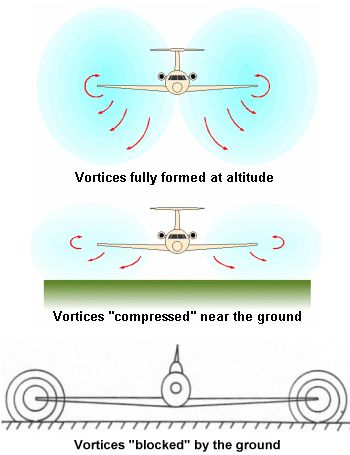
An additional bonus of ground effect that becomes more significant as speed increases is called ram pressure. As the distance between the wing and ground decreases, the incoming air is "rammed" in between the two surfaces and becomes more compressed. This effect increases the pressure on the lower surface of the wing to create additional lift.
As you might expect, the impact of ground effect increases the closer to the ground that a wing operates. As indicated in the plot shown below, ground effect typically does not exist when a plane operates more than one wingspan above the surface. At an altitude of 1/10 wingspan, however, induced drag is decreased by half.
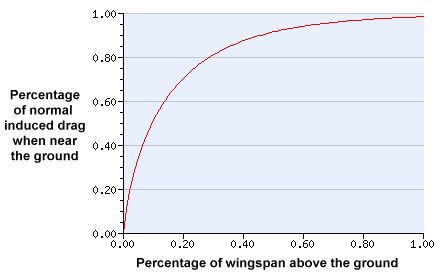
When all of these benefits are taken into account, we find that a vehicle operating in ground effect has the potential to be much more efficient than an aircraft operating at high altitude. The aerodynamic efficiency of an aircraft is expressed through a quantity called the lift-to-drag ratio, or L/D. In steady, level, non-accelerating flight, a plane's lift is equal to its weight, and the amount of thrust required is equal to the drag it produces. Therefore, the L/D ratio is a measure of the weight that can be carried for a given amount of thrust. The higher the L/D, the more efficient the vehicle. Typical L/D values for conventional, subsonic aircraft are on the order of 15 to 20. By comparison, a ground effect vehicle could, in theory, achieve L/D ratios closer to 25 or 30.
Though ground effect has been known since the early days of flight, most pilots regarded it as nothing more than a nuisance that changed the flying qualities of their aircraft during takeoff and landing. Nevertheless, many researchers soon realized that this phenomenon could be exploited to produce a new class of highly efficient craft known as WIG vehicles. Most of the pioneering research into these vehicles was performed in West Germany and the Soviet Union.
Perhaps the most successful researcher in this field was Rostislav Alexeiev, head of the Central Hydrofoil Design Bureau in the Soviet Union from the 1950s through the early 1970s. Alexeiev began his career developing hydrofoils, which are boats fitted with underwater wings. When the boat moves, these wing create lift that pulls the boat hull up and out of the water and allows the craft to cruise at higher speeds. But Alexeiev quickly realized that a hydrofoil can only go so fast due to the drag created by the dense water through which it "flies." Why not instead raise the entire vehicle out of the water and cruise at even higher speeds, he reasoned. This line of thought led to a new vehicle with wings above the surface of the water, a vehicle the size of a boat and able to carry a massive payload but able to cruise at the speed of an aircraft. Another advantage of such a vehicle would be the ability to fly at very low altitudes, below the detection range of enemy radar. Alexeiev dubbed this new class of vehicle the Ekranoplan, which is Russian for "screen plane." His early designs were numbered under the SM series, an acronym standing for Samorodnaya Model, meaning "self sustained craft."
Alexeiev developed a number of sub-scale designs in experimental tests that culminated in 1965 with the completion of the KM , the largest WIG vehicle ever built. Making its first flight on 18 October 1966, the KM was powered by a whopping 10 turbojet engines and weighed up to 540 tons. Eight of the engines were mounted near the vehicle's nose so that their thrust could be deflected underneath the wing to create an initial cushion of air that raised the KM out of the water. Once the craft was traveling fast enough that the wings generated sufficient lift to keep the vehicle above the water, the thrust was redirected aft to increase velocity.
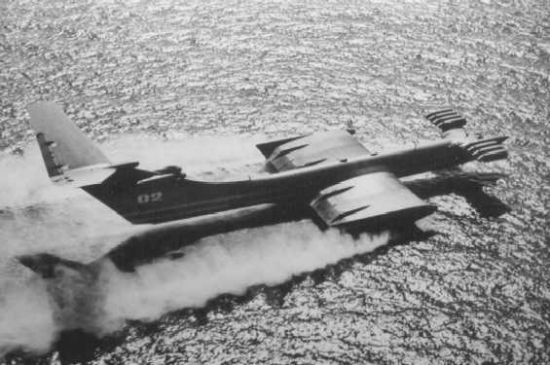
The KM was modified numerous times to evaluate the effects of different design elements. Among these changes included varying the wingspan from 105 ft (32 m) to 131 ft (40 m) and increasing the fuselage length from 302 ft (92 m) to 347 ft (106 m). The KM, also dubbed the Caspian Sea Monster by American observers who spotted the craft in satellite surveillance, remained in use until 1980 when it crashed during takeoff.
Although Alexeiev passed away in 1980, his design bureau continued to build and test Ekranoplans until the collapse of the Soviet Union. One of the more successful concepts was the Lun, which began trials on the Caspian Sea in 1987. The Lun was of similar design to the KM but smaller and built to carry anti-ship cruise missiles for high-speed attacks against American carrier battle groups.

However, the changing political tide and struggling economy in the Soviet Union caused the Ekranoplan concept to fall out of favor, and a second Lun was never completed. The Alexeiev Design Bureau remains in operation and continues to propose new designs for civilian use, but the market has not yet developed.
Nevertheless, Boeing has recently taken interest in the WIG phenomenon and proposed a concept for a massive craft to meet a US Army need for a long-range heavy transport. Called the Pelican, the 500 ft (153 m) span vehicle would carry up to 2,800,000 lb (1,270,060 kg) of cargo while cruising as low as 20 ft (6 m) over water or up to 20,000 ft (6,100 m) over land. Unlike the Soviet concepts, the Pelican would not operate from water, but from conventional runways using a series of 76 wheels as landing gear.
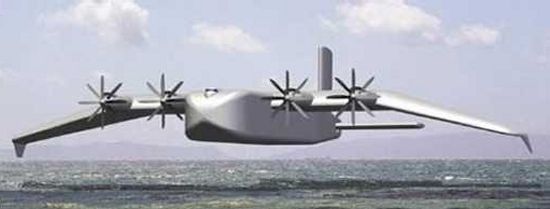
The outboard wing sections, shown tilted downward in the above image to optimize efficiency in ground effect, would be swiveled upward to provide clearance for runway operations. Power for the craft would be supplied by four advanced turboprop engines. The Pelican would also have two cargo decks. The lower deck would be sized for large cargos, including up to 17 main battle tanks, while the upper deck would be used for troops or cargo pallets. With a maximum takeoff weight up to 3,000 tons, the Pelican would have a wing area of more than an acre.
The Pelican is a logical extension of Rostislav Alexeiev's work. As big as the KM prototype was, it was simply too small to take full advantage of the benefits of ground effect. Indeed, Alexeiev had proposed much larger versions of the KM and Lun able to carry up to a thousand armed troops and their ground vehicles. The principal advantage of a WIG vehicle is the ability to move very heavy loads in a craft with a relatively small wingspan and low aspect ratio wing with great aerodynamic efficiency. Exemplifying this strategy is Boeing's claim that the Pelican is capable of transporting 750 tons over 10,000 nm (18,530 km) when cruising in ground effect, but can carry the same load only 6,500 nm (12,045 km) when out of ground effect.
So the WIG concept is clearly not new, and has been implemented by several manufacturers. However, none has really caught on, and the primary reason is that ground effect craft only become truly practical for very large vehicles, even larger than the massive KM. The reasoning is as follows. As discussed above, the amount of lift a flying vehicle needs to generate is directly related to its weight. The heavier a plane is, the more lift it needs, so the larger its wings must be (for the same cruise speed). This basic relation becomes a problem when we consider very heavy aircraft. As payload weight increases, wing size increases which requires larger and heavier structures that further increase overall weight. As weight increases, additional thrust and fuel is required to push the vehicle at its desired cruise speed over the required range, and the need for larger or additional engines plus greater fuel capacity further increases the overall weight of the vehicle. This trend pushes manufacturers towards increasingly complicated and expensive design solutions that make very large and heavy aircraft unprofitable to build.
However, the beauty of ground effect is that a given amount of wing area produces more lift near the ground than it would at high altitude. Or in other words, the same payload can be transported with a much smaller wing, which translates directly into a smaller, lighter, and more fuel efficient craft. It is therefore not surprising that most advocates of WIG vehicles have focused on very large vehicles, like Boeing's Pelican. This is not to say that vehicles at the other end of the size spectrum have been ignored. Quite the contrary, far more small WIG craft have been built and flown than large craft like the KM. Manufacturers around the world, particularly in Germany, have constructed a variety of small WIG vehicles designed for a handful of passengers. One such example is the L-325, a four-passenger craft built by the American company Flarecraft.
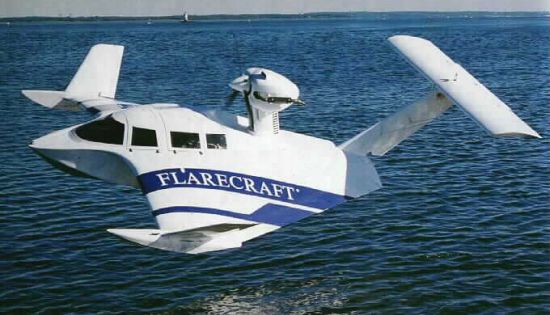
So why haven't these smaller craft become a commercial success? Unfortunately, most of the improvements in efficiency that make a large WIG vehicle attractive do not translate as well across the spectrum to their smaller cousins. The same reductions in induced drag and the ability to lift a given payload with a smaller wing still apply, but the benefits are not as pronounced. While a craft operating close to the ground experiences a reduction in induced drag, other forms of drag are increased. Most importantly, WIG vehicles experience greater skin friction drag simply because the air is denser at sea level than it is at high altitude. A large vehicle can tolerate this increase because the decrease in induced drag is far more significant. But for a small vehicle, the decrease in induced drag and increase in skin friction drag are more equal, so only marginal improvements in overall efficiency are possible.
Furthermore, the increased drag created by denser air at low altitudes limits maximum speed, so a WIG craft will take more time to travel a given distance than a comparable aircraft operating at high altitude. Again, this performance penalty is less significant for a large WIG craft since they would likely be used for transporting large cargos, and speed can be sacrificed for lower cost. Commercial passengers, on the other hand, would be less likely to accept longer travel times than are currently possible with modern airliners.
For these reasons, the future of WIG craft remains uncertain. The potential benefits of ground effect are indeed attractive, but it is unclear whether those benefits are significant enough to warrant construction of large enough vehicles to take full advantage of them. The Pelican is an intriguing concept that could revolutionize the transportation of very heavy payloads, but only time will tell whether or not it is just a pipe dream.
An excellent resource for further information on the aerodynamics, design, and history of Wing in Ground Effect
vehicles as well as details about specific craft and their manufacturers is
The WIG Page.
- answer by Jeff Scott, 29 June 2003
Related Topics:
Read More Articles:


|
Aircraft | Design | Ask Us | Shop | Search |

|
|
| About Us | Contact Us | Copyright © 1997- | |||
|
|
|||